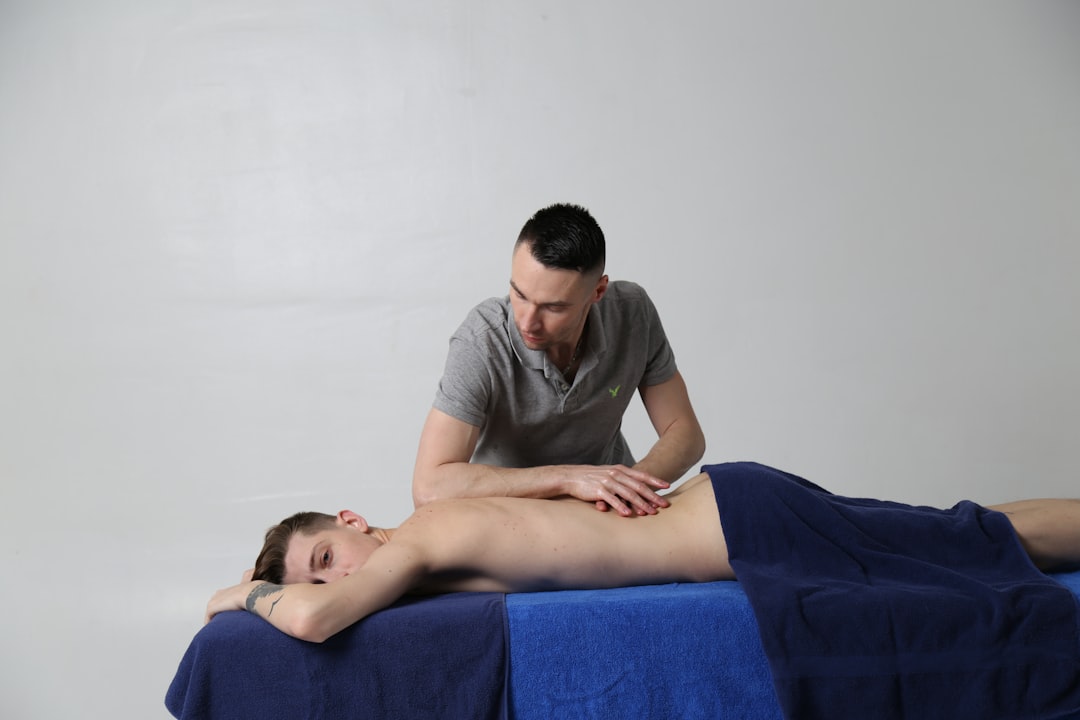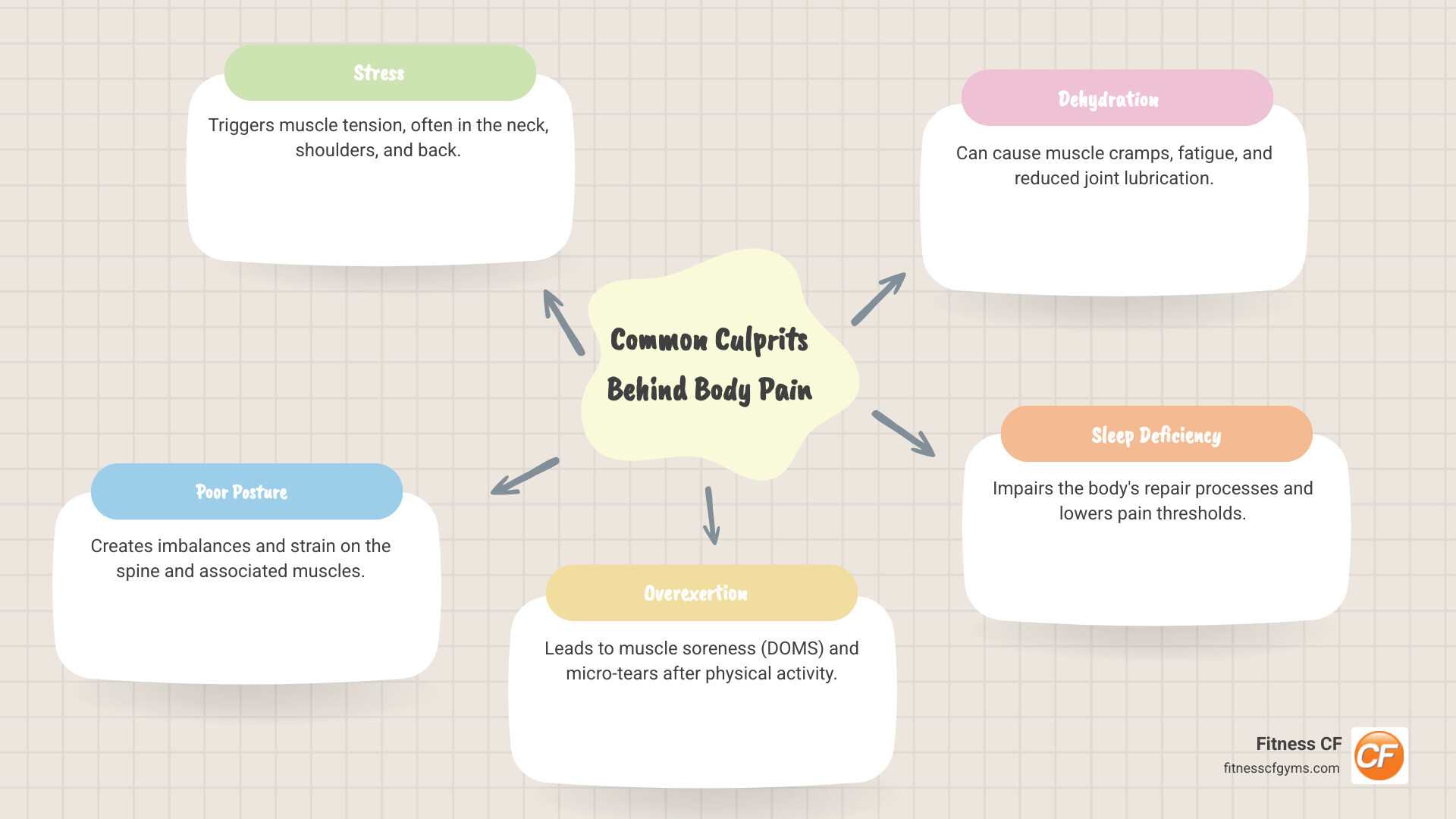Myalgia Mystery: Understanding and Easing Muscle Pain

Why Your Body Aches and How You Can Find Relief
Learning how to ease body pain is essential for an active lifestyle. Whether it’s muscle soreness after a workout, stiffness from sitting, or general aches, body pain affects millions. Medically known as myalgia, these aches can stem from viral infections, stress, dehydration, or poor posture. Fortunately, most muscle pain responds well to simple, natural approaches.
Quick ways to ease body pain:
- Move gently – Light walking or stretching increases blood flow.
- Apply heat or cold – Use heat for stiff muscles and ice for acute injuries.
- Stay hydrated – Drink plenty of water to prevent muscle cramps.
- Get quality sleep – Aim for 7+ hours to help your body repair.
- Practice stress management – Try deep breathing or meditation.
- Eat anti-inflammatory foods – Include omega-3s, berries, and leafy greens.
Understanding your pain is the first step. Acute pain is sudden and short-lived, often from overexertion. Chronic pain persists for weeks or months and may signal underlying conditions. Effective pain management requires a holistic approach, addressing lifestyle factors like movement, nutrition, sleep, and stress.
I’m Pleasant Lewis, a fitness professional with 40 years of experience helping people find relief through movement and healthy lifestyle changes. My experience shows that combining gentle exercise with smart recovery strategies is the most effective path to easing body pain.

Unpacking the Causes: Why Does My Body Ache?
Understanding how to ease body pain starts with identifying its cause. Aches and pains are warning lights telling you something needs attention, from simple dehydration to the effects of a modern, sedentary lifestyle.

Acute vs. Chronic Pain: Understanding the Difference
Knowing the type of pain you have helps determine the best response.
Acute pain is your body’s alarm system. It appears quickly and is short-lived, like the soreness you feel after a new workout. This discomfort from sore muscles after exercise is a sign your body is adapting and getting stronger. It can also accompany illnesses like the flu as your immune system works to heal you.
Chronic pain is persistent, lasting for weeks, months, or even years. It can significantly impact your quality of life and often stems from underlying conditions that need ongoing attention. Examples include fibromyalgia, which causes widespread pain and fatigue, arthritis, which leads to joint inflammation, and some autoimmune disorders.
Common Culprits Behind Everyday Aches
Many aches are caused by everyday lifestyle factors.
- Stress: When you’re stressed, your muscles tense up. Chronic stress leads to constant muscle tension, aches, and increased inflammation. The stress and its impact on the body is significant.
- Dehydration: Muscles need water to function. Without enough, they can cramp and feel sore. Even mild dehydration can worsen joint pain.
- Poor Sleep: Your body repairs itself during sleep. A lack of quality sleep hinders tissue repair and inflammation management, creating a cycle of pain and exhaustion. There is a strong link between sleep deficiency and pain.
- Poor Posture and Sedentary Habits: Spending hours hunched over a desk or phone strains your neck, shoulders, and back. A lack of regular movement causes muscles to become stiff and weak. Incorporating regular movement and strength training can reverse many of these issues.
How to Ease Body Pain with Movement and Lifestyle Changes
Effective strategies for how to ease body pain focus on simple lifestyle changes that support your body’s natural healing. Movement, nutrition, sleep, and stress management are the four pillars of natural pain relief.

The Power of Gentle Exercise for Pain Relief
When your body hurts, gentle movement is often the best medicine. It acts as a natural lubricant for stiff joints and tight muscles. Physical activity increases blood flow, delivering oxygen and nutrients to healing areas while flushing out inflammatory substances. Start gently and listen to your body. Low-impact activities like walking, swimming, and yoga are excellent choices. Proper The Importance of Warm-Up and Cool-Down Exercises: A Comprehensive Guide and regular Stretching Routines to Improve Flexibility and Prevent Injuries are crucial for safety and effectiveness. Aim for the recommended 150 minutes of moderate activity per week, which is just over 20 minutes a day.
The Benefits of Strength Training
Building muscle is a powerful long-term strategy for how to ease body pain. Strong muscles act as shock absorbers, supporting joints and reducing stress on your lower back and knees. Strength training also improves metabolism and makes daily tasks easier, reducing injury risk. You can start with bodyweight exercises and progress gradually, improving daily function and preventing future injuries.
The Benefits of Cardio Exercise
Cardiovascular exercise like brisk walking or cycling is a natural mood booster and pain reliever. It prompts your body to release endorphins, which act as natural painkillers. Cardio improves circulation for faster recovery and supports weight management, which reduces stress on joints. The increased endurance makes it easier to stay active, creating a positive cycle of movement and pain relief.
Fueling Your Body: Nutrition and Hydration
An anti-inflammatory diet can significantly reduce pain. Focus on:
- Colorful fruits and vegetables: Rich in antioxidants that calm inflammation.
- Omega-3 fatty acids: Found in fatty fish, walnuts, and flaxseeds, they have powerful anti-inflammatory properties.
- Turmeric: Contains curcumin, a compound with notable anti-inflammatory benefits.
- Tart cherry juice: May help with muscle soreness due to its anthocyanin content.
Proper hydration is also key. Dehydration can cause muscle cramps and worsen joint stiffness. Aim to drink water consistently, especially during exercise, to support good things for muscle recovery. Limiting inflammatory foods like processed items and sugary drinks is also beneficial.
The Crucial Role of Sleep and Stress Management
Your body repairs itself during sleep. Consistent sleep habits are vital for healing. Create a restful environment and follow a regular schedule. As Pain Concern suggests, there are many tips for getting a good night’s sleep when dealing with discomfort.
Stress reduction techniques provide immediate and long-term pain relief. Simple practices like deep breathing, meditation, and mindfulness can activate your body’s relaxation response, reduce muscle tension, and change how your nervous system responds to pain. Understanding Active Recovery for Athletes can also provide insights into managing stress while staying active.
At-Home Remedies and Therapies for Immediate Relief
When body aches strike, simple home remedies can provide immediate comfort and support your body’s healing process. Learning how to ease body pain at home is a key part of self-care.

Simple Home Remedies for How to Ease Body Pain
Heat therapy, like a warm bath or heating pad, increases blood flow and relaxes stiff muscles, making it ideal for chronic pain. Cold therapy, using an ice pack, constricts blood vessels to reduce inflammation and is best for acute injuries. An Epsom salt bath combines heat with magnesium, a natural muscle relaxant, to soothe aches after a tough workout.
For strains and sprains, the R.I.C.E. method is a trusted approach: Rest, Ice, Compression, and Elevation. This helps manage swelling and initiates healing. For more recovery tips, see our guide to Alleviate Sore Muscles After Workout.
The key is knowing when to use which therapy:
| Feature | Heat Therapy | Cold Therapy |
|---|---|---|
| Purpose | Relaxes muscles, increases blood flow, reduces stiffness | Reduces inflammation, swelling, numbs pain |
| Best for | Chronic pain, muscle soreness, stiffness, older injuries | Acute injuries, sprains, strains, throbbing pain |
| Application | Warm baths, heating pads, warm compresses | Ice packs (wrapped), cold compresses, ice baths |
| Duration | 15-30 minutes | 15-20 minutes |
Exploring Natural Supplements and Topical Solutions
Given the risks of long-term NSAID use, many people explore natural alternatives. Consider these options:
- Turmeric: Its active compound, curcumin, is a powerful natural anti-inflammatory.
- Glucosamine and Chondroitin: These supplements support cartilage health and may reduce joint-related pain.
- Omega-3 Fatty Acids: Fish oil supplements offer anti-inflammatory benefits throughout the body.
- Topical pain relievers: Creams with capsaicin (warming) or menthol (cooling) can provide targeted relief.
Always consult your doctor before starting new supplements, as quality can vary and interactions are possible. You can check supplement safety with the NCCIH. These natural tools work best when combined with a healthy lifestyle.
The Mind-Body Connection: Psychological Approaches to Pain
Your mind and body are a team. How you think, feel, and handle stress can dramatically change your pain experience. Learning how to ease body pain involves mental tools to break the cycle where pain causes stress, and stress worsens pain.

Mental Techniques for How to Ease Body Pain
These techniques are mental workouts that build your pain management skills.
- Breathing Techniques: Slow, deep belly breathing can tell your nervous system to relax, reducing muscle tension.
- Distraction: Engaging in an enjoyable hobby, book, or music can provide real relief because your brain has less capacity to process pain signals.
- Mindfulness Meditation: This practice teaches you to observe pain without judgment. By not fighting the discomfort, it often becomes more manageable.
- Pacing Activities: For ongoing pain, balance activity with rest, even on good days. This prevents the boom-bust cycle of overexertion followed by a painful flare-up.
The Strength in Support: Talking and Sharing
Connecting with others can be as healing as any physical treatment.
- Cognitive Behavioral Therapy (CBT): A therapist can help you identify and change negative thought patterns that worsen pain, retraining your brain to respond in healthier ways.
- Social Support: Talking with supportive friends and family releases feel-good chemicals that can reduce pain signals. Organizations like The Pain Toolkit and Pain Concern also offer valuable resources and community.
Strengthening your mental coping skills often leads to improved physical symptoms, demonstrating the power of the mind-body connection.
When to Seek Professional Help
While home strategies for how to ease body pain are effective, it’s crucial to know when to seek professional help. Listening to your body’s warning signs is a smart part of self-care.
Consult a healthcare provider if you experience:
- Severe or persistent pain that doesn’t improve with home care or lasts more than a week without a clear cause.
- Pain accompanied by fever, which could signal an infection.
- New numbness, tingling, or weakness in your limbs.
- Unexplained weight loss or a new rash along with your pain.
Certain symptoms are medical emergencies and require immediate attention, including difficulty breathing, vision changes, a stiff neck, or loss of bowel or bladder control.
If pain disrupts your sleep or daily life, a healthcare provider can offer an accurate diagnosis and advanced treatment options. Physical therapy is also highly valuable for musculoskeletal pain. A physical therapist can design a personalized program to strengthen muscles, improve flexibility, and correct movement patterns, as detailed in our guide on How to Prevent and Recover from Common Workout Injuries.
Working with a qualified fitness professional can also provide the custom guidance needed to move safely. This personalized approach is key to long-term pain management, as highlighted in The Benefits of Personal Training: Tailoring Your Fitness Journey. Seeking professional help is a proactive step toward lasting relief.
Conclusion
Learning how to ease body pain is about building a toolkit of strategies that support your body’s natural healing. Effective pain management combines understanding your body’s signals with thoughtful action through movement, nutrition, rest, and stress management.
Your body is resilient. By providing the right conditions—gentle exercise, anti-inflammatory foods, quality sleep, and stress reduction—you empower its ability to heal. These strategies work together, creating a positive cycle where moving more improves sleep, which in turn helps manage stress and reduce inflammation. Start with small, consistent changes, like a daily walk or drinking more water, and build from there.
At Fitness CF, we know that movement is medicine. We are committed to helping you find fitness that feels good for your body. We believe strength training builds a resilient foundation, while cardio boosts circulation and releases natural, pain-fighting endorphins.
Recovery is just as important as the workout. Our specialized amenities are designed to support your healing. Explore our HydroMassage and other recovery amenities to soothe tired muscles and accelerate recovery.
Your journey to feeling better starts with a single step. Trust your body, be patient with the process, and remember that seeking help is a sign of strength. You have the power to take control of your pain and live a more comfortable, active life.





